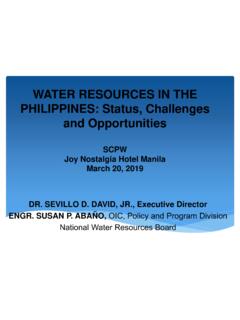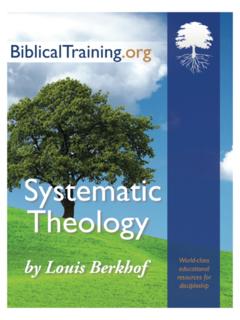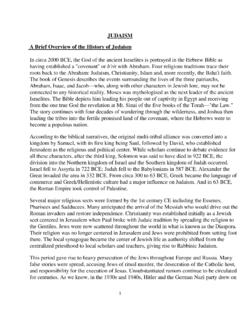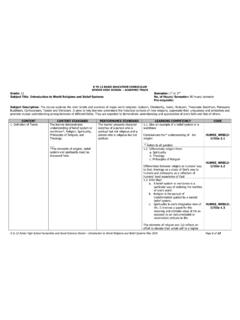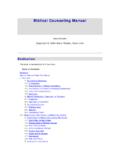Transcription of The Seven Environmental Principles* - Wetlands
1 The Seven Environmental Principles* is connected to everything else. (Ang lahat ng bagay ay magkakaugnay.)The intricate relationships of various elements of the ecosystem bind the components together intoone functional unit. The trees in theforest are home to ferns, orchids, birds, insects and these plants and animals die, their products of decomposition contribute to soil fertility. Plantsprovide oxygen to animals for aerobic respiration while animals furnish carbon dioxideto plants forphotosynthesis. The quality of the soil determines the type of vegetation that exists while vegetationcontributes to the minerals of the soil when they die. The living component of the ecosystem affectsand is affected by the abiotic components, such as air, temperature, land. Inter-specific relationshipscreate a dependency with each other so that they both have to co-exist to live.
2 All these relationshipsprovide dependencies, check and balances that compose the details of our life-support interaction with nature oftentimes alters the ecosystems. The waste we improperly disposeof brings about the deterioration of land and water quality. This may in turn reduce their capacity toprovide life for other organisms. Deforestation causes soil erosion and the earth deposited on the waterbodies covers the coral reefs resulting to fishery loss. Suspended particulates from vehicular andstationary sources may cause lung problems among city residents. War causes destruction ofwildlifeand habitats. There is a cause and effect chain, even when it is neither always visible nor economic systems affect the distribution of biological goods worldwide. Through the Galleontrade, spices reached different parts ofthe world.
3 Today, oranges and apples from China have becomeeasily accessible to the Filipino market. Developing countries argue that globalization promotes theintroduction of species detrimental to the recipient habitat and forms of life are important.(Ang lahat na may buhay ay mahalaga.)All living organisms were created for a purpose in relation to humans, other species on earth andglobal ecosystem in general. Thus, when a species becomes extinct, it is like removing a piece of ajigsawpuzzle from the web of life. The variety of life forms, manifested by the different levels ofbiological diversity community, species and genes contributes to the stability of the webs, food chains and ecological relationships linkplants and animals together in the web of bacteria, insects, snakes and rats have ecological functions even though humans perceive them asparasites or Philippines ranks high among the biodiversity hotspots the richest but the mostthreatened ofterrestrial ecosystems in the world.
4 The Philippines has rich flora and fauna: an estimated 13,500 plantspecies, 80 amphibians, 240 reptiles, 556 birds, 174 mammals, 300 corals, 27 mangrove species. Ofthese, approximately 75% are endemic. Some of the threatened species are the Philippine eagle(Pythecophaga jefferyi), Philippine crocodile (Crocodylus mindorensis), and Tamaraw (Bubalusmindorensis).The composition of biological diversity naturally changes slowly but the rate of transition hasbecome faster due to factors such as habitat destruction. Deforestation may diminish forest speciessuch as birds that are vulnerable to modification of their home. Pollution of waters reduces the quantityof fishes, shells, algae and other aquatic life. Over harvesting of natural products likewise contributes tothe unsustainable use of food and material maintain ecological balance, therefore, the conservation of genes, species and ecosystemsbecomes essential to keep life conservation strategies commence with theprotection of both terrestrial and aquatic ecosystems.
5 Land uses, such as protected areas, ensure thatthe natural state of these habitats continue to exist in designated areas. Community-based approachesin conservation maximize citizens participation in protected areas. Integrity of natural ecosystems canlikewise be guarded through the preservation of indigenous outside of the protected areas can be adopted. Cities and human settlements can stillkeep trees, patches of forests and garden as home for wildlife like birds, butterflies, and ecosystems sustain the variety of plants and animals through inter-cropping, multi-croppingand crop rotation. Plantand animal breeding can increase the population of commercially importantspecies without directly harvesting from the wild. The captive breeding of Pag-asa, the Philippine eagle,provided a solution to the diminishing eagle population.
6 Although it is still recommended that habitatprotection must be the first step to species must go somewhere. (Ang lahat ng bagay ay may patutunguhan.)By-products of consumption go back to the environment. Everything that we throw away piecesof paper, left-over food, peelings of fruits, plastic wrappers, used containers have to go plants and animals have their own wastes feces, urine, dead leaves and branches. It is the law ofnature that the by-products of metabolism return to the soil, acted upon first by worms, bacteria andfungi, and then converted into minerals, to be again absorbed by plants and eaten by animals. In short,they enter into a material cycle that is an integral part of the ecosystem. But what happensif what wethrow is an artificial product such as plastic?
7 Then natural bacteria can not recognize them and may notbe capable of breaking them apart. These non-biodegradable products must enter another materialcycle the one that goes to the factory to be manufactured into a new product. Thus the retrieval,collection and recycling of these materials become necessary so that they do not pollute land and our present consumer-oriented, setting up an ecological solid waste managementsystembecomes necessary for maximizing the use of resources. Ecological solid waste managementrecommends that solid wastes be reduced, segregated, re-used and recycled. Biodegradable materialsare either to be eaten again or composted. Non-biodegradable materials have to be segregated andcollected for have their own responsibility in reducing their effluents.
8 End-of-the-pipelinetechnologies are augmented by clean technologies in raw product extraction and manufacturing. The polluters pay principle adopted by governments intensifies the campaign for clean land, water and exchange programs by industry turn wastes of one industry into raw products of another. In thatway, habitats for organisms are not destroyed is a finite earth. (Ang kalikasan ay may hangganan.)Everything that we need is provided by nature in abundance food, water, energy, minerals and , some resources that we depend upon nowadays are extracted excessively butare slow toreplace. These non-renewable resources experience limits of supply. For instance, fossil fuels producedover thousands of years may be exhausted in a hundred years. Some energy sources like water, andwood may be replaced easier but have become inaccessible due to pollution and excessive forest cover have resulted from logging, ineffective reforestation and continued landconversion.
9 However, food scarcity and poverty may have resulted from failed distribution systemsrather than inability of the land and water bodies to yield can be argued that increasing population decreases the amount of resources available to eachperson. Carrying capacity, or the ability of the ecosystem to support a number of people,may beinfluenced by limit of resources due to an increasing population. Competition increases as the carryingcapacity is reached. Per capita consumption must also be taken into account because people inNorthern countries generally consume more food, energy and resources than people in the developingSouthern countries. Carrying capacity may be addressed two ways: increase resources and reducepopulation growth. Agricultural productivity for instance may be increased with better availability ofwaterand farm reduces the absorbing capacity of air and water.
10 Pollution likewise reduces theavailability of land and water to produce food for human consumption. A river classified a Class IVmeans that it becomes fit only for only for navigation and can no longer sustain life forms. Likewise, oilspills from accidents or war destroy bays and rivers. Waterways that have become cesspool of domesticwastes cannot contain fishes and shells or if they do might transmit toxins and harmful bacteria solutions have been suggested to solve this problem: reduction of consumption,increased use of renewable energy, emissions trading, and pollution control. The conservation ethic andtechnological solutions have become viable strategies to address finiteness of resources. Biodiversityconservation is anchored on the principle that lost species are irreplaceable.
